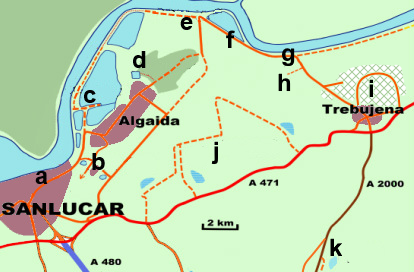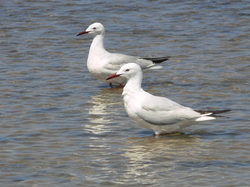Sanlucar - Bonanza - Trebujena

Birding sites around Sanlucar de Barameda
My full notes on this area (see 'Home page' for details) run to 5 pages with 7 detailed maps) so what follows here is a mere 'taster' of this superb area. For simplicity an approach from the general direction of Sanlucar is assumed. As with other maps & notes the letter/number code refers to my site guide to the area.
Why visit? Specialities: Azure-winged Magpie, Pin-tailed Sandgrouse, Marbled Teal & White-headed Duck. Waders, terns, gulls raptors, larks, etc
a) Sanlucar de Barameda - the town's narrow streets and cinvoluted one-way system makes it a nightmare to drive round so I usually park on the outskirts and walk in. Not a great birding site in itself, but the boat trip up river (from the old Ice House at the northern end of the promenade) is a good excuse for a 'family' birding trip - gulls (Audouin's & Slender-billed possible) waders, terns, etc. Don't miss out on Sanlucar's famous sea food restaurants - said to be the best in Spain or, if here in August, the famous horse racing on the beach!
b) - 'Martin Miguel' & Bonanza Pools - getting to Bonanza via Sanlucar involves a messy drive through unattractive suburbs so I prefer to head towards Trebujena on the A471 and turn back towards the town by its eastern most exit but almost immediately take a minor road north towards Algaida. This overlooks marshes to the right and after c2km some raised lagoons on the left ("Martin Miguel" pools). In winter these often attract White-headed Duck whilst during passage may have Whiskered Tern, Little Gull, etc. The nearby field has a large Collared Pratincole colony. "Bonanza Pools" can be accessed via a minor road (Camino Truncosa) near a large white industrial building about 1km south of the turning for Bonanza saltpans. These old clay pits, surreounded by "plastico-agriculture" are very good for close views of Little Bittern & White-headed Duck (and, in recent years, more reliable than nearby Laguna Tarelo).
c) - Bonanza Saltpans (salinas) - these are now 'open access' and well signposted off the Sanlucar/Bonanza - Algaida road (just look for the large 'National Park' sign by the entrance). Explore the birdlife of the salinas via the good gravel tracks (private roads are clearly marked as such) for Flamingos, Black-winged Stilt, a good mix of smaller waders, Slender-billed Gulls, Whiskered & Caspian Terns, a good selection of raptors (esp. Red Kite), wintering Black Stork and much else. Check out the river for waders, terns, gulls, etc. The track running north along the river is in a pitiful state (only the ambitious or foolhardy can follow it round by car to NW2.5), but walk up to the tamarisks and beyond for Spectacled Warbler, Short-toed and Lesser Short-toed Lark. Spanish Imperial Eagle is possible - keep a sharp look out for large raptors soaring ver the far side of the river (i.e. the Coto Donana).
d) - Algaida Pinewoods & Laguna Tarelo - Laguna Tarelo is on the left as you enter the pines (from Algaida). The island heronry has breeding Spoonbill, Night & Squacco Herons, Little & Cattle Egrets. Black-necked Grebe, Red-crested Pochard and White-headed Ducks (much reduced in recent years) are present. The woods harbour Cadiz province's only Azure-winged Magpies but they can be extremely elusive here (try around the picnic sites). The wood also has a large colony of breeding Black Kites and is a good numbers of the localised Tree Sparrow.
e) - Guadalquivir (west) - follow the corrugated track through pines to the open marshland beyond and head up towards the river and an embanked road. Turn left along the river on a good gravel track by the weir. This takes you back towards Bonanza salinas - look out for waders, Spectacled Warbler, Short-toed and Lesser Short-toed Lark. The dry saline fields here are said to hold Pin-tailed Sandgrouse.
f) Codo de la Esparrauera - Returning to the weir head towards Trebujena (take care when stopping as cars often speed along this newly repaired road). Check the pools on the left carefully for Marbled Teal (for which this is one of the most relaible spots in Spain). In winter check ditches for Bluethroat.
g) Nature Reserve - just after where the track turns away from the river there is now a small reserve with hides and pools - check for waders, ducks, larks, warblers, etc
h) Adventus Marshes - a rough track near a large white finca leads off into the marshes - often excellent in spring BUT note that when wet this clay road can be dangerously slippery and undrivable.
i) Trebujena - the extensive area of crganically grown small plots of vineyards around the town are excellent for Rufous Bushchats - please respect plotholders and the bird (no playback, please)
j)'Inner' Marshes - the fast A471 between Sanlucar & Trebujena has several tracks leading off it ino the marshes to the north (see map). These can be explored with care (be prepared to 'overshoot' & turn back rather than risk a sharp turn on this often busy road). In spring/winter large shallow pools can hold numerous waders (inc. Little Stint), Glossy Ibis, herons, Black Storks, etc. Raptors can be numerous (inc. Montagu's Harrier). Short-toed Lark are abundant. Pin-tailed Sandgrouse are present in drier areas but very elusive.
k) Mesa de Asta Marsh - as the newly upgraded (A2000) road between Trebujena and Jerez swings round Mesa de Asta pull over onto a small track to view, albeit distantly, this excellent small marsh - there's a large Gull-billed Tern colony here and the site can attract a good variety of waders (inc. Collared Pratincole) and during the summer there's usually a few Montagu's Harrier around. (Note although the main track is clearly private, closer viewing may be possible to the left further along the gravel track beyond the small ford, but take care not to alarm nesting birds)
Access - If heading for Bonanza saltpans head into Sanlucar follow directions for Bonanza, but if heading for Algaida it is easier to take the minor just inland and enter the upper part of the village .
Why visit? Specialities: Azure-winged Magpie, Pin-tailed Sandgrouse, Marbled Teal & White-headed Duck. Waders, terns, gulls raptors, larks, etc
a) Sanlucar de Barameda - the town's narrow streets and cinvoluted one-way system makes it a nightmare to drive round so I usually park on the outskirts and walk in. Not a great birding site in itself, but the boat trip up river (from the old Ice House at the northern end of the promenade) is a good excuse for a 'family' birding trip - gulls (Audouin's & Slender-billed possible) waders, terns, etc. Don't miss out on Sanlucar's famous sea food restaurants - said to be the best in Spain or, if here in August, the famous horse racing on the beach!
b) - 'Martin Miguel' & Bonanza Pools - getting to Bonanza via Sanlucar involves a messy drive through unattractive suburbs so I prefer to head towards Trebujena on the A471 and turn back towards the town by its eastern most exit but almost immediately take a minor road north towards Algaida. This overlooks marshes to the right and after c2km some raised lagoons on the left ("Martin Miguel" pools). In winter these often attract White-headed Duck whilst during passage may have Whiskered Tern, Little Gull, etc. The nearby field has a large Collared Pratincole colony. "Bonanza Pools" can be accessed via a minor road (Camino Truncosa) near a large white industrial building about 1km south of the turning for Bonanza saltpans. These old clay pits, surreounded by "plastico-agriculture" are very good for close views of Little Bittern & White-headed Duck (and, in recent years, more reliable than nearby Laguna Tarelo).
c) - Bonanza Saltpans (salinas) - these are now 'open access' and well signposted off the Sanlucar/Bonanza - Algaida road (just look for the large 'National Park' sign by the entrance). Explore the birdlife of the salinas via the good gravel tracks (private roads are clearly marked as such) for Flamingos, Black-winged Stilt, a good mix of smaller waders, Slender-billed Gulls, Whiskered & Caspian Terns, a good selection of raptors (esp. Red Kite), wintering Black Stork and much else. Check out the river for waders, terns, gulls, etc. The track running north along the river is in a pitiful state (only the ambitious or foolhardy can follow it round by car to NW2.5), but walk up to the tamarisks and beyond for Spectacled Warbler, Short-toed and Lesser Short-toed Lark. Spanish Imperial Eagle is possible - keep a sharp look out for large raptors soaring ver the far side of the river (i.e. the Coto Donana).
d) - Algaida Pinewoods & Laguna Tarelo - Laguna Tarelo is on the left as you enter the pines (from Algaida). The island heronry has breeding Spoonbill, Night & Squacco Herons, Little & Cattle Egrets. Black-necked Grebe, Red-crested Pochard and White-headed Ducks (much reduced in recent years) are present. The woods harbour Cadiz province's only Azure-winged Magpies but they can be extremely elusive here (try around the picnic sites). The wood also has a large colony of breeding Black Kites and is a good numbers of the localised Tree Sparrow.
e) - Guadalquivir (west) - follow the corrugated track through pines to the open marshland beyond and head up towards the river and an embanked road. Turn left along the river on a good gravel track by the weir. This takes you back towards Bonanza salinas - look out for waders, Spectacled Warbler, Short-toed and Lesser Short-toed Lark. The dry saline fields here are said to hold Pin-tailed Sandgrouse.
f) Codo de la Esparrauera - Returning to the weir head towards Trebujena (take care when stopping as cars often speed along this newly repaired road). Check the pools on the left carefully for Marbled Teal (for which this is one of the most relaible spots in Spain). In winter check ditches for Bluethroat.
g) Nature Reserve - just after where the track turns away from the river there is now a small reserve with hides and pools - check for waders, ducks, larks, warblers, etc
h) Adventus Marshes - a rough track near a large white finca leads off into the marshes - often excellent in spring BUT note that when wet this clay road can be dangerously slippery and undrivable.
i) Trebujena - the extensive area of crganically grown small plots of vineyards around the town are excellent for Rufous Bushchats - please respect plotholders and the bird (no playback, please)
j)'Inner' Marshes - the fast A471 between Sanlucar & Trebujena has several tracks leading off it ino the marshes to the north (see map). These can be explored with care (be prepared to 'overshoot' & turn back rather than risk a sharp turn on this often busy road). In spring/winter large shallow pools can hold numerous waders (inc. Little Stint), Glossy Ibis, herons, Black Storks, etc. Raptors can be numerous (inc. Montagu's Harrier). Short-toed Lark are abundant. Pin-tailed Sandgrouse are present in drier areas but very elusive.
k) Mesa de Asta Marsh - as the newly upgraded (A2000) road between Trebujena and Jerez swings round Mesa de Asta pull over onto a small track to view, albeit distantly, this excellent small marsh - there's a large Gull-billed Tern colony here and the site can attract a good variety of waders (inc. Collared Pratincole) and during the summer there's usually a few Montagu's Harrier around. (Note although the main track is clearly private, closer viewing may be possible to the left further along the gravel track beyond the small ford, but take care not to alarm nesting birds)
Access - If heading for Bonanza saltpans head into Sanlucar follow directions for Bonanza, but if heading for Algaida it is easier to take the minor just inland and enter the upper part of the village .

